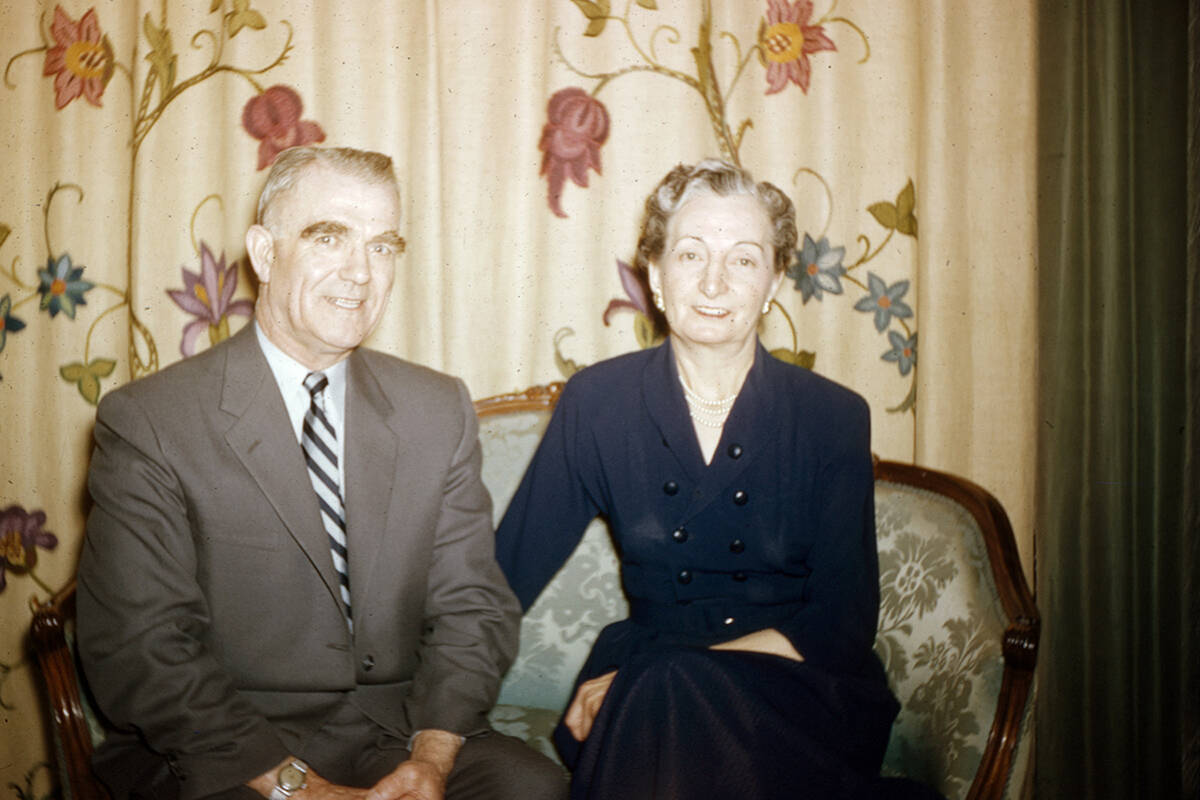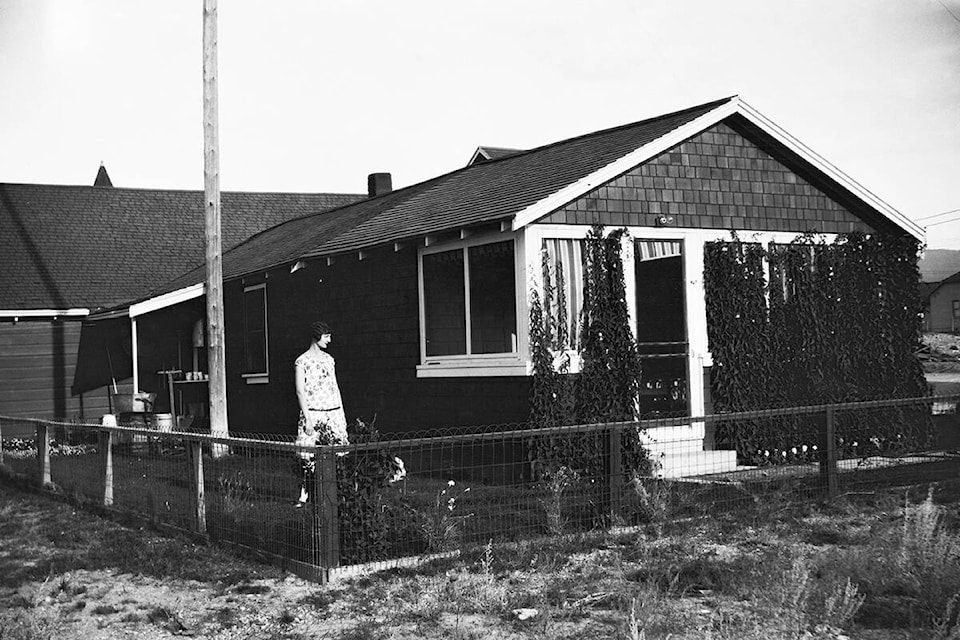by Massimo Calabrese
Special to the Tribune
In 1919, the Pacific Great Eastern Railway reached the Cariboo Chilcotin. A station was built at a place called Williams Lake, named after a Secwépemc chief who had first encountered European fur traders there nearly 100 years prior. His real name was Gwesemiyst (also spelled Wese7meyist), but the fur traders called him William. Several kilometres east, past the opposite end of the lake, was the Onward Ranch. At that time, the ranch was owned by Mr. John Edgar Moore, and it was proposed as an alternative site for the PGE station at Williams Lake. In the end, the railway company opted for the first option.
Already waiting when the first trains arrived was Fraser and Mackenzie, a general store owned by Mr. John Fraser and Mr. Roderick Mackenzie that supplied the settlers of the area like Mr. Harold Curtis and Mr. Benjamin F. Clarke. Soon, other stores began opening up along the railway. Next door was Fox’s, a barbershop and pool hall owned by Mr. Humphrey Hanford Fox. There was Smedley and Sharp, a building supply store owned by Mr. John Dexter Smedley and Mr. William Sharp; T.A. Moore’s, a grocery store owned by Mr. Thomas Allan Moore; Rife’s Drug Store, owned by Mr. William Arthur Rife; and a number of hotels including The Lakeview, owned by Mr. Jack Chow. Further back was the Oliver Theatre, built by Mr. Arthur Hillier and soon purchased by Mr. William Sydney Western.
I’m sure many of these names are familiar to the old-timers and history enthusiasts out there. If you haven’t noticed yet, there is something in common with all these people whose names are so synonymous with early Williams Lake.
All of them are men.
I’m not suggesting that these men did not play an important part in the foundation of this city. For better or for worse, each was intrinsically linked to the growth of this new village built upon land that had just 60 years prior been a winter village site called Yucwt for the local Secwépemc people. What I am suggesting, however, is that the role of men in history is often the only role portrayed or recorded, and the very important role of women is almost always overlooked in early histories of small communities like ours.
There is one Williams Lake woman in particular who I feel has been especially overlooked by history given her extensive connections to the area, and that is Cordelia Ann Moore. You’ve already read about three of her relatives and three operations in which she was directly involved just in the opening of this article, maybe without even realizing it. Needless to say, she deserves her own story. Luckily for us, I have been able to uncover many details of Cordelia’s fascinating life, often hidden behind the accomplishments of men.
Cordelia Ann Moore was born on June 22, 1896, at the Alkali Lake Ranch. She was the second youngest of eight children, with three sisters and four brothers. Her parents were John Edgar Moore and Anna Maria “Annie” Chiaro. Annie’s father and Cordelia’s grandfather, Francesco, had started part of the ranch on the 160 acres of land given to him by the colonial government as an Italian immigrant. Francesco’s wife and Cordelia’s grandmother was Margaret Squalietiche of the Esk’etemc First Nation.
In 1902, Cordelia’s father sold the Alkali Lake Ranch and purchased the Onward Ranch from John Eagle and Thomas Paxton for $25,500. Both men were in debt and the ranch was completely run down, leaving the Moore family with a lot of work to do. They fixed up the house and other farm buildings and employed Chinese workers to dig irrigation ditches. As the children grew up, they took on more responsibilities. Cordelia’s brother George William Moore eventually took over ownership from their father, and her brother Thomas Allan “Tommy” Moore opened the T.A. Moore grocery store in Williams Lake.
Sometime around the 1910s, Cordelia (or “Dilly” as she was known by) came to own a Kodak folding camera and began to photograph life on the Onward Ranch. Very few people in Williams Lake, and especially very few women, would have owned a camera in those days. In 1916 Dilly married Newton Harvey “Newt” Clare when she was 19 and he was 22. Newt helped run a pool hall upstairs at the T.A. Moore and was an organizer of the town’s first car service that ran from Ashcroft to Barkerville. He would eventually open a car garage on Railway Avenue, and later became a Justice of the Peace. Dilly got a job as bookkeeper at her brother’s store, and in 1922 the family sold the Onward Ranch and moved to town. This was the same year that William Sydney “Syd” Western was hired as manager at the T.A. Moore.
Over the next four years, Syd and Dilly would get to know each other well. So well, in fact, that they got married on September 5, 1926. The wedding took place in the Moore family house, or “Moore House,” a recreation of which stands today at 321 Second Avenue North, marked with a sign and commemorative plaque.
Their honeymoon consisted of a tour of Northern B.C. I couldn’t determine when Newt and Dilly officially separated, but it was no earlier than November 1924. In the meantime, Dilly had served as the secretary of the first hospital auxiliary board in 1923 and had won the annual Masquerade Ball Halloween costume contest in 1924 dressed as a Christmas tree.
She attended and photographed many early Williams Lake Stampedes. The year Syd and Dilly were married was also the year they bought the Oliver Theatre on the corner of Oliver Street and Second Avenue and moved in next door.
Although it was Syd’s dream to own a movie theatre, he and Dilly owned the Oliver Theatre together, with Syd as manager and projectionist and Dilly as bookkeeper and ticket seller. In 1951, they built a new theatre on the other side of their house. In 1956 they named it the Alston Theatre, presumably after Syd’s youngest brother Thomas Alston Western who died in 1936 at the age of 34, possibly by suicide. Syd and Dilly sold the Alston and retired in 1958.
Syd and Dilly never had any children themselves, but the Westerns were known for being extremely welcoming and kind to those from other local families. David Gosman, now in his eighties, recalls escaping his house as a toddler, fully naked, and ending up in the Westerns’ garden on Oliver Street. They promptly returned him home to his mother, Veera.
In the 1950s, after moving to Johnson Street, the Westerns had a friendly rivalry with their neighbours, the Whytes, during the Kiwanis Club Christmas light contest. Each went as far as to accuse the other household (via the Williams Lake Tribune) of stealing light bulbs in the dead of night. Living near the hospital, the Westerns’ electric garage door (the first in town) was set off on a daily basis by the hospital’s x-ray machine.
Ken Poirier remembers childhood Boxing Days spent with the Westerns watching the neighbours throw their still-decorated Christmas tree out to the curb. Dilly gifted Ken’s mother her cherished Christmas platter, which Ken still owns.
After a five-year battle with heart illness, Dilly passed away in Williams Lake on January 14, 1975, at the age of 78. Later that year, Syd moved to Kamloops, and eventually ended up in the South Granville Park Lodge retirement home in Vancouver. In 1983, he donated the large collection of photographs taken by Dilly (and some by him) to the Williams Lake Archives. Syd passed away on December 30, 1991, at the age of 94.
The Westerns are remembered fondly for their kindness and generosity, and their records of community involvement speak for themselves. Although she is often simply referred to as “Mrs. Syd Western,” Cordelia Moore was an incredibly interesting character of early Williams Lake who gives us an important look into the lives of women during that time. She reminds us why it’s important to seek out under-represented voices and groups throughout history.
I was extremely excited to help facilitate the transfer of the Westerns’ photo collection from the Williams Lake Archives at the CRD Library to the Museum of the Cariboo Chilcotin last summer. Thank you to Anton Dounts for allowing it to happen. Over 300 priceless photographs have now been digitized by Project Coordinator Casey Bennett, and many are currently on display as part of the Museum’s new photo exhibit, “The Laketown.” Dilly’s early photos are identifiable by a small, rectangular light leak in the upper left corner, caused by a defect in her camera. The photo exhibit and virtual historic tour of downtown are on the museum’s website, and a full exhibit is now open at the museum, 1660 Broadway Avenue South, in the Tourism Discovery Centre.
Thank you to everyone who shared their stories and memories with me. If you have any stories or photos of Syd or Dilly Western, the Alston Theatre, or anything to do with early Williams Lake businesses, please reach out to me on Facebook or by email at calabrese.williamslake@gmail.com.
Massimo Calabrese is a local history enthusiast, university student and has worked as a summer student at the Museum of the Cariboo Chilcotin in the recent past.
Do you have a comment about this story? email:
editor@wltribune.com
Like us on Facebook and follow us on Twitter.

